mobile View, to the German Version tap the flag


- Grand Duchy of Saxony-Weimar-Eisenach (Sachsen-Weimar-Eisenach)
- from 1903 Grand Duchy of Saxony
- to 1920 country of the German Empire
- 1920 merged into Thuringia
• Flags
• Meaning/Origin of the Flag
• Coat of Arms
• Meaning/Origin of the Coat of Arms
• Cockade
• Map
• Numbers and Facts
• History
• Origin of the Country's Name

to 1813,
Colours of the country,
Source, by: World Statesmen



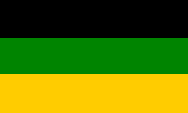
1813(?)–1897,
Flag of the country (Colours of the country),
Source, by: World Statesmen,
Jens Hild,
Flags of the World



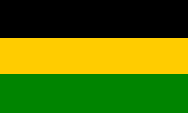
1897–1920,
Flag of the country (Colours of the country),
Source, by: World Statesmen,
Jens Hild,
Flags of the World



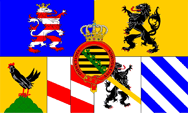
ca.1862–ca.1878,
Flag of the Grand Duke,
Source, by: Flags of the World



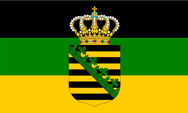
ca.1878–1897,
Flag of the Grand Duke,
Source, by: Flags of the World by Siebmacher 1878



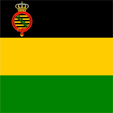
1897–1903,
Flag of the Grand Duke,
Source, by: Flags of the World by Siebmacher 1878



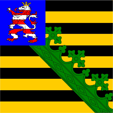
1903–1918,
Flag of the Grand Duke,
Source, by: Ruhmr. Fahnen dt. Geschichte






The colors of the House Wettin are blue and yellow. They have their roots most likely in the crest of the Dominion of Landsberg. These colors were worn by members of the Swiss Guards at the electoral-saxon courts. The bands of some medals had been blue-yellow too. Black and yellow were for centuries the colours (livery color) of the Saxon courts (Albertine and Ernestine). They have their roots the regular coat of arms (black lion in golden field, which later became the arms of the Margraviate of Meissen) or in the coat of arms of the Duchy of Saxony. Black and yellow were used for certificate cords and for many military ensigns since the 17th century. However, national colors in the true sense, they were not yet.
The former Albertine electorate and new kingdom of Saxony joined the Rhine Confederation on 11th of December in 1806, on 15th of December in 1806 followed by the Ernestine duchies in Thuringia. The troops of the duchies were consolidated and equipped with cockades in black and gold in accordance with the convention of the 13th of February in 1807. The cockades of the Kingdom of Saxony remained white.
After the Battle of Leipzig Saxony became occupied (as a former ally of Napoleon), and it was formed the General Government of Saxony, which included Saxony-Altenburg and the Principalities of Reuss. As Governor General was installed the Russian Prince Nikolai Repnin-Volkonsky Grigojewitsch. Even in 1813 was proposed from the Saxon side (and approved by the Governor General), to create for Saxony a new gree-black-yellow cockade. The Grand Duchy of Saxony-Weimar-Eisenach followed this rule.
When the Saxon King Friedrich August I., of the dynasty of the Albertine Wettins, in May 1815 was returning home from captivity to Saxony after the end of the liberation wars against Napoleon, he instructed Lieutenant General of Lecoq at the 22nd of May in 1815, to reorganize and bring home, the at the River Rhine standing Saxon troops. The there until this point in time still white cockades on the caps of the soldiers were to surround with a green edge by this instruction of the king to avoid confusions with other troops. The news about the creation of the color combination of white and green spread very quickly, and arrived Saxony before the king. So he was received by his people with white and green garlands, flags and ribbons. In recognition of this fact, the monarch decided on 16th of June in 1815 to take over the white-green cockade for national cockade. That was the birth of the white and green as the colors of Saxony. The Saxon duchies (Thuringia), ruled by the Ernestine Wettins took mostly over these arrangements for their colors and flags.
Saxony-Weimar-Eisenach did not follow, and retained the color combination of green-black-yellow. The probable reason for this, should have been close kinship connections to the Russian court, and that Duke Karl August has been a Russian cavalry general and commander during the War of Liberation against Napoléon. Not least, Duke Karl August was raised to a Grand Duke by the influence of the Russian Tsar during the Congress of Vienna in 1815.
The colours of the German states are (called Landesfarben, are often derived from the colours of the coats of arms, and used as cockades, as well as flags), were formed – especially in the German inland countries – rather late, often after the French Revolution and the following wars of liberation. In the period from ca. 1815 to ca. 1830, this process was finally completed in all German states.
Since 1885 was used, especially at the grand ducal court, the in the heraldic point of view better color sequence of black-yellow-green for the flags. In the afteryears, there were frequently requests about the correct color sequence, and so the ministry of state issued on 29th of January in 1897 a notice, which officially stipulated the color sequence of black-yellow-green as correct. Withe the cockades this change took a little bit longer. The new color-sequence was here taken over about 1900.
The colours of the small Thuringian States persisted after the abdication of the princes, even after the formation of the State of Thuringia on 5th of January in 1920, but they became territorial flags. On 25th of April in 1922 was adopted the "Regulation on the flagging of state buildings", which laid down, that the previous territorial flags have to be no longer in use. Just the abolition of the territories on 1st of April in 1923, was the end for the colours of the former Thuringian States.
Source: Volker Preuß,
Jens Hild,
www.sachsenlied.de,
Flags of the World


Lesser Coat of arms of Saxony-Weimar-Eisenach,
Source, by: Deutsche Wappen Rolle
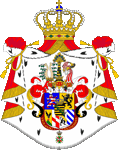
Greater Coat of arms of Saxony-Weimar-Eisenach,
Source, by: Deutsche Wappen Rolle

Shield of the greater Coat of arms of Saxony-Weimar-Eisenach,
Source, by: Deutsche Wappen Rolle

The central element of the heraldry of the Saxon monarchies is the Saxon coat of arms. It was created around 1180 when the Ascanians, margraves of Brandenburg and counts of Ballenstedt became the dukes of Saxony: a green diamond wreath was placed over the black and golden coat of arms of Ballenstedt. In principle, the title of the Duke of Saxony migrated up the Elbe to what is now central Germany, as it was lent to various noble families (last 1423 the Wettins). In 1485 the "Leipzig division" of the Wettin lands took place between the brothers Duke Albrecht (ancestor of the Albertines) and Elector Ernst (ancestor of the Ernestines). The Ernestines divided into many lines, which retained the Saxon heraldry. One of them was Saxony-Weimar-Eisenach.
About the coat of arms: The greater coat of arms (mantle and pavilion with crown, shield with 3 helmets with crests and mantling) showed at least on the shield next to 4 fields (two of them halved vertically), the Saxon coat of arms as heart shield. The first field shows the Landgraviate of Thuringia (white-red striped lion on blue), the second field shows the Margraviate of Meißen (black lion on gold), the third field (halved vertically) the County of Henneberg (black hen on a green mountain against a golden background) and the Dominion of Neustadt-Arnshaugk (silver and red halved vertically, each with an diagonally right inclined bar in alternating colors), the fourth field the Dominion of Blankenhain (black lion on silver with a golden diagonally right inclined bar) and the Dominion of Tautenberg (blue and silver eight times right inclined diagonally striped). The lesser coat of arms (shield and crown) showed only the Saxon coat of arms.
Source: Volker Preuß,
Deutsche Wappen Rolle


to 1807,
Cockade of Saxony-Weimar-Eisenach,
Source, by: Jens Hild

1807–1813,
Cockade of Saxony-Weimar-Eisenach,
Source, by: Jens Hild

1813–ca.1883(?),
Cockade of Saxony-Weimar-Eisenach,
Source, by: Jens Hild

ca.1883(?)–ca.1900,
Cockade of Saxony-Weimar-Eisenach,
Source, by: Jens Hild

ca.1900–1919,
Cockade of Saxony-Weimar-Eisenach,
Source, by: Jens Hild
The cockade of the troops of the Kingdom of Saxony (and from 1807 of the Duchy of Warsaw too) has been single-colored white since 1744. After the Battle of Leipzig Saxony became occupied (as a former ally of Napoleon), and it was formed the General Government of Saxony, which included Saxony-Altenburg and the Principalities of Reuss. As Governor General was installed the Russian Prince Nikolai Repnin-Volkonsky Grigojewitsch. Even in 1813 was proposed from the Saxon side (and approved by the Governor General), to replace the existing white cockades by a new cockade. It showed the colors green, black and yellow, all colors taken from the Saxon coat of arms. Black and yellow are the national colors, and green is the color of the rhombus wreath. Black and yellow, not entirely coincidental, have been also the colors of the Russian coat of arms and of the cockade of the imperial-russian troops.
When the Saxon King Friedrich August I., of the dynasty of the Albertine Wettins, in May 1815 was returning home from captivity to Saxony after the end of the liberation wars against Napoleon, he instructed Lieutenant General of Lecoq at the 22nd of May in 1815, to reorganize and bring home, the at the River Rhine standing Saxon troops. The there until this point in time still white cockades on the caps of the soldiers were to surround with a green edge by this instruction of the king to avoid confusions with other troops. The news about the creation of the color combination of white and green spread very quickly, and arrived Saxony before the king. So he was received by his people with white and green garlands, flags and ribbons. In recognition of this fact, the monarch decided on 16th of June in 1815 to take over the white-green cockade for national cockade. That was the birth of the white and green as the colors of Saxony. The Saxon duchies (Thuringia), ruled by the Ernestine Wettins took mostly over these arrangements for their colors and flags. (more about the
saxon cockade ← click here).
Saxony-Weimar-Eisenach did not follow, and retained the color combination of green-black-yellow. The probable reason for this, should have been close kinship connections to the Russian court, and that Duke Karl August has been a Russian cavalry general and commander during the War of Liberation against Napoléon. Not least, Duke Karl August was raised to a Grand Duke by the influence of the Russian Tsar during the Congress of Vienna in 1815.
Source: Volker Preuß,
Jens Hild,
Deutsche Wappen Rolle

Read here:
Informations, history and facts about the theme "Cockades".

Cockade

The Thuringian Staates:
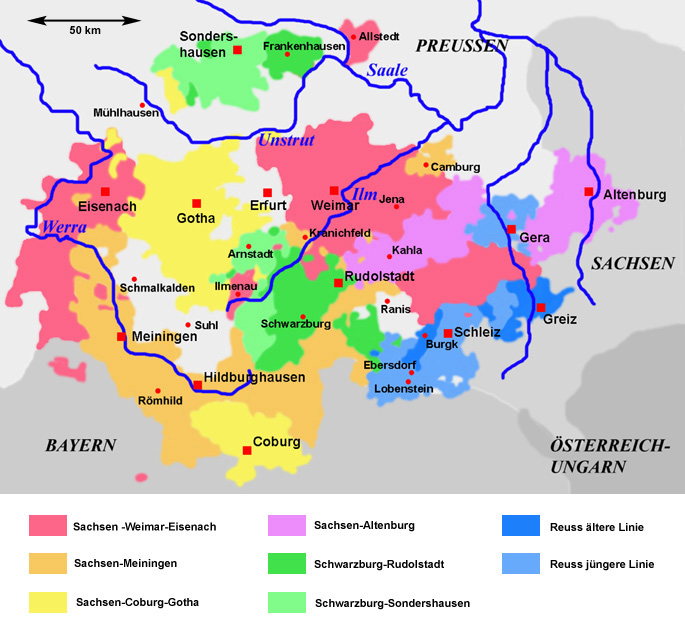
Source:
Volker Preuß
The map shows the Grand Duchy of Saxony-Weimar-Eisenach between the years 1867 and 1918 in red.

Area: 1.394 square miles (1910)
Inhabitants: 417.150 (1910)
Density of Population: 299 inh./sq.mi. (1910)
Hauptstädte: Weimar
Currency to 1875: 1 Taler = 30 Groschen = 360 Pfennige
Currency 1875–1920: 1 Mark = 100 Pfennig
Source: Der Michel,
Wikipedia (D)

1264 · the Landgraviate of Thuringia (then much larger) was divided after a war of succession, the Margrave of Meißen from the House of Wettin received the eastern part, the Landgraviate of Thuringia (almost all of today's Thuringia), the western part became the Landgraviate of Hesse
1342–1346 · the House Wettin can prevail against a coalition of local Thuringian counts, the counts have to take their land from the Margrave of Meißen and Landgrave of Thuringia to fief, after their extinction these areas fell to Thuringia (except Schwarzburg and Reuss)
1423 · the Margrave of Meissen, Friedrich 'the Martial', got Saxony-Wittenberg (Electorate of Saxony) as fiefdom, thereafter gradual pass of the name "Saxony" to the Margraviate of Meissen
1485 · "Leipzig Partition" of the Wettin's estates between the brethren Duke Albrecht (progenitor of the Wettin-Albertinians) and Elector Ernst (progenitor of the Wettin-Ernestinians); Duke Albrecht: County of Meissen, western Osterland, North Thuringia; Elector Ernst: Electorate of Saxony, South Thuringia, Vogtland
1547 · "Wittenberg Capitulation" the dignity of election passes from the Ernestinians (Duke Johann Friedrich I.) to the Albertinians (Duke Moritz of Saxony), Johann Friedrich I., who resided in Wittenberg, has to go into captivity
1552 · Duke Johann Friedrich I came from captivity and moved his residence to Weimar, which gave the Ernestine Duchy the name Saxony-Weimar
1572 · Erfurt Division, Saxony-Weimar is divided into the Duchy of Saxony-Weimar and the Duchy of Saxony-Coburg-Eisenach
1596 · division of Saxony-Coburg-Eisenach into Saxony-Coburg and Saxony-Eisenach
1633 · the line of Saxony-Coburg dies out, the legacy goes to Saxony-Eisenach
1638 · the line of Saxony-Eisenach dies out, the legacy goes to Saxony-Weimar and Saxony-Altenburg
1640 · Ernestine division, Duke Wilhelm IV. divides his Duchy Saxony-Weimar into the Duchy of Saxony-Eisenach, under his brother Albrecht, and the Duchy of Saxony-Gotha, under his brother Ernst I. (the Pious)
1741 · the duchies of Saxony-Weimar and Saxony-Eisenach are now governed in personal union (Duke Ernst August I. of Saxony-Weimar-Eisenach), but administered separately
1806 · joining of Saxony-Weimar-Eisenach to the Rhine Confederation
1809 · the duchies of Saxony-Weimar and Saxony-Eisenach are now united administratively
1815 · joining to the German Confederation, elevation to a Grand Duchy
1866 · in the Brother War on the hands of Prussia, joining to the North German Confederation
1871 · joining of the Grand Duchy of Saxony-Weimar-Eisenach to the German Empire
1903 · the country officially changes its name to the Grand Duchy of Saxony (also in use before)
1918 · fall of the monarchy, formation of the Free People's State of Saxony-Weimar-Eisenach
1st of May in 1920 · dissolved in Thuringia
Source: Wikipedia (D),
RetroBib Retrobibliothek,
Atlas zur Geschichte

The origin of the name "Saxony" lies in the 5th century in the old Duchy of the Saxons in what is now northwest Germany.
The country was smashed by the German emperor in 1180, but the title of "Duke of Saxony" was retained. It was connected to the outskirts of the old duchy and, with the lending to various noble families, the name in principle migrated up the Elbe River to today's Saxony (the then Margraviate of Meissen under the house Wettin) in central Germany. To distinguish it from the real Saxon (the old Duchy), the Saxon of the house of Wettin was called "Upper Saxony". This remained until the term "Hanover" had prevailed for the old Saxon areas, which today are roughly summarized in "Lower Saxony".
The name "Saxony" was transferred to the Thuringian areas in 1485 when the Wettin Saxon was divided into the lines of the Albertines and Ernestines. Since the dukes rejected the promogenitur there for a long time, the duchies were often shared between all the sons, and a dense network of small partial duchies arised (named after the capital of the duchy), which had been oftenly linked to each other, which had been allocated to the various family lines. The were often inherited, partially inherited or even exchanged. This was always reflected in the name of the respective duchy. For example, Saxony-Coburg-Saalfeld ceded the partial duchy of Saalfeld and got the partial duchy of Gotha. This is how the Duchy of Saxony-Coburg-Gotha came into being, consisting of the two sub-duchies (partial duchies) of Coburg and Gotha.
The name Thuringia for the whole region has been preserved, it comes from the old Kingdom of Thuringia, which was destroyed and annexed by the Franks in the 6th century. The Duchy of Thuringia was founded in the 7th century, which in turn only lasted for one century. This was not a tribal duchy, however, since the Thuringians no longer existed. In 1131 the later Emperor Lothar III. established the Landgraviate of Thuringia and gave it to the House of the Ludovingians, who died out in 1247. The country was divided in 1264 after a war of succession between the House of Wettin (as the Landgraviate of Thuringia) and the House of Brabant (as the Landgraviate of Hesse).
Source: Volker Preuß









![]()

































